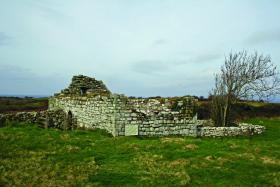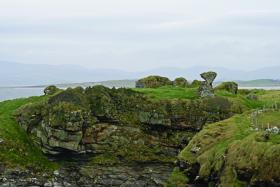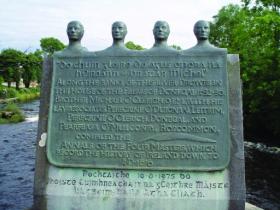The O’Clerys: hereditary historians and poets
Published in Features, Issue 3 (May/June 2010), Medieval History (pre-1500), Volume 18
The ruin of Kilbarron church outside Ballyshannon, Co. Donegal, near the site of the O’Clerys’ bardic school
The forebears of the O’Clerys had been kings of Connacht and later lords in Kilmacduagh diocese in south County Galway until Anglo-Norman invaders expelled them in the thirteenth century. According to historian Edel Bhreathnach, the O’Clerys and other aristocratic poets
‘. . . all belonged to families from the north and west of Ireland who had practised the arts of history and poetry throughout the late medieval period. They sustained important schools of learning, were hereditary keepers of medieval churches, and possessed extensive lands and other wealth as a consequence of their profession and the nobility that accrued to it.’
Other hereditary poet families (and their lords) in this period included O’Curneen (O’Rourke), O’Mulconry (O’Conor), O’Higinn (O’Brien), O’Hussey (Maguire), MacNamee (O’Neill) and O’Daly (O’Reilly).
Kilbarron bardic school

The crumbling ruin of their castle on a cliff top at nearby Creevy above Donegal Bay. (Sheila Gallagher)
The O’Clerys’ school of literature, history and poetry was located in Kilbarron near Ballyshannon, Co. Donegal. It stood outside their castle, where they kept a house of hospitality. Historian Eugene O’Curry described their school as ‘the last and greatest school of Irish historians’.
Their once-renowned castle is now a crumbling ruin that clings to a Creevy cliffside above Donegal Bay’s rocky shore. Four bare stone walls, all that is left of their church, stand in desolation in an empty field, the ruin identified by a historical plaque commemorating their stewardship. No trace of their school’s stone buildings remains. These bardic colleges were called ‘the schools’. They operated in parallel to monastic or ecclesiastical schools.
Entrants came from two select groups—children of poets and highly regarded, intelligent youth. Both groups had to be able to read and write Irish with great fluency and to memorise a massive number of long verse poems and prose tales. The six-month school year began at the end of September, broke for Christmas holidays and concluded at the end of March. At the start of the school year, students gave gifts and other payments to their masters to defray the expense of their instruction, lodging and meals. Gentlemen landowners and farmers supported the schools, supplying abundant quantities of provisions as well as entertaining students at weekends.
The curriculum included memorisation drills, composition exercises and recitations. To prevent distraction, students composed in complete darkness while lying in bed. The poets themselves referred to their education in a special phrase—‘to lie in the bed of the schools’. After composing their poems mentally, students drafted handwritten versions by candlelight and recited them for their teachers to approve or correct.
An aspiring poet had to complete twelve years of training to qualify as a scholar. A trained scholar (ollamh) could versify on any subject on demand, as well as recite any one of c. 350 long verse poems and prose tales. He was a master of grammar, law, philosophy, history, geography, genealogy, myths and the near-forgotten older Irish of the poet class.
Generally, a chieftain would select his official poet from the trained scholar cohort. The number of chief poet positions corresponded approximately to the number of Gaelic chiefs and their ‘countries’ (tuatha)—more than 60, according to a 1515 English report.
Role of the poet
A chief’s poet served as his master’s key adviser. His principal duty was to compose poems of high praise to promote popular support for his chief. He could counsel his chief on public relations and diplomacy issues and serve as his chief’s official envoy. He acted also as a communicator who disseminated news and important information to the local population. According to historian Osborn Bergin, a chief’s poet was
‘. . . a professor of literature and a man of letters, highly trained in the use of polished literary medium, belonging to a hereditary caste in an aristocratic society, holding an official position therein by virtue of his training, his learning, his knowledge of the history and traditions of his country and his clan. He was often a public official, a chronicler, a political essayist, a keen and satirical observer of his fellow-countrymen.’
His poems could praise his chief’s bravery and hospitality, pronounce on enemies curses whose words were believed to carry a magical power to inflict harm, incite plunder of clan rivals, recount feats of heroism, and mark births, marriages and deaths in the chief’s family. Reciters, who were not poets, actually declaimed or chanted the poems, accompanied by a harpist.
A chief’s poet was official keeper of his chief’s genealogy and the clan history, and recorder of boundaries, tributes and exactions. He was an expert in feineachas (law) and in coimhghne (historical knowledge, memory and the construction of genealogies).

The Four Masters Bridge on the River Drowes at Mullinaleck, Kinlough, Co. Leitrim, near the Franciscan friary where the Annals were compiled between 1632 and 1636. (Sheila Gallagher)
He could accept commissions from other chiefs and patrons. Maccon O’Clery wrote a poem c. 1585–92 about an O’Donnell clan rival, Philip O’Reilly, lord of Clankee barony in County Cavan. The poem, commissioned by O’Reilly’s wife, Rose Maguire, was titled ‘How should I praise the son of a king’. In eulogistic verses praising his own chief, however, a poet could not mention rivals and opponents. His wealthy and educated benefactors treasured and carefully preserved in family archives the verses, lyrics, moral or didactic essays and political pamphlets written about them. Bergin says that much of the extant bardic poetry ‘consists of elaborate panegyrics on patrons and benefactors’.
The poet’s high rank entitled him to special privileges and lucrative rewards. These included sitting at the chief’s side, getting the choicest cut of meat, receiving large land holdings tax-free and wearing garments containing the colour gold. The chief poet of a territory had the privilege of taking as a fee the wedding garments of every woman married within it. Poets took payment in land, gold rings, jewelry and livestock such as cattle, sheep or fine horses.
A poet could act as a social critic but not with impunity. Englishman Edmund Campion wrote c. 1571 that the Irish ‘esteeme their Poets who write Irish learnedly, and penne their sonnetts heroicall, for the which they are bountifully rewarded. But if they send out libells in disprayse, thereof the Gentlemen, especially the meere [native] Irish, stand in great awe’. An O’Brien prince of Thomond and English ally, who wanted to exterminate all the Irish poets, ordered three of them hanged, including in 1572 Maurice Ballach O’Clery. The O’Clerys were known for their hospitality to the indigent and the mighty. Typically, though, poets acted with arrogance and greed. Historian Marc Caball observed that the poets as a class were so self-interested that they only reacted to events if they threatened to ‘impinge on their professional status and financial well-being’.
Scholar Edward O’Reilly’s 1820 chronology listed nearly 400 poets and writers—from Amergin to William buidhe O’Kiaran (c. 1750). It includes 28 O’Dalys, nine O’Mulconrys, eight O’Higinnses, eight Wards, seven O’Coffeys and eleven O’Clerys. Two O’Clery poets on O’Reilly’s list wrote prose masterworks: Louis O’Clery wrote the Life of Red Hugh O’Donnell, and his younger cousin, Michael O’Clery, compiled the Annals of the Kingdom of Ireland (see sidebars).
The last of the bardic schools closed in about 1641. O’Clery descendants in County Cavan continued the bardic tradition for nearly another century. Among the eleven O’Clerys in O’Reilly’s chronology is Fr Thomas O’Clery, a Catholic priest in Killann parish, known as a poet. He wrote at least two poems in Irish and may also have written a 1703 lament on the death of Philip Oge O’Reilly. Thomas the priest or another Thomas O’Clery wrote twenty verses on Rory McMahon, chief of his name, around this time as well. The last O’Clery listed by O’Reilly was Brian ‘rabhagh’ O’Clery, c. 1730, a native of Moybologue, who wrote at least two poems in Irish that have survived.
The provenance of Cucogry O’Clery’s books
In 1664 Cucogry O’Clery wrote a one-page will that left his books to his sons. It read in part: ‘I bequeath the property most dear to me that ever I possessed in this world, namely, my books, to my sons Dermot and Seán’. The books, all in his handwriting, included The O’Clery Book of Genealogies, the Life of Red Hugh O’Donnell, the Book of Invasions, the Topographical Poems of O’Dugan and O’Heerin, and miscellaneous verse and prose compositions.
In 1817 his descendant John O’Clery moved from Drung, Co. Cavan, to Dublin. He brought the books with him. Years later he lent them to an acquaintance, Edward O’Reilly, who kept them. When O’Reilly died, his executor, Revd Eugene O’Reilly of Navan, a relative, arranged to sell his collection of books and manuscripts. The auctioneer listed Cucogry’s books on the handbills. The O’Clerys by chance obtained a handbill and John O’Clery appealed to the priest for the return of his lawful property. But the latter ignored O’Clery’s affidavit, which declared that O’Clery had lent and not sold the books to O’Reilly.
In 1830 the Royal Irish Academy purchased the books, which also contained the will. In 1842 John O’Clery’s son, John junior, wrote to the historian John O’Donovan, alleging that his father had lent the books to O’Reilly, who never returned them. He also claimed that O’Reilly had sold Cucogry’s copy of Louis O’Clery’s biography of Red Hugh, ‘and this he had done without letting my father know anything about it’. HI
Patrick Clark, a New Yorker, has Ralaghan, Co. Cavan, roots and holds dual Irish and American citizenship.
Further reading:
E. Bhreathnach & B. Cunningham (eds), Writing Irish history: the Four Masters and their world (Dublin, 2007).
P.A. Breathnach, The Chief’s Poet (Dublin, 1983).
B. Cunningham, O’Donnell histories: Donegal and the Annals of the Four Masters (Rathmullen, 2007).
D. Greene (ed.), Irish bardic poetry [with introductory lecture by Osborn Bergin] (Dublin, 1970).
















